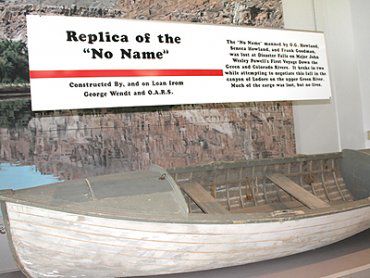The John Wesley Powell River History Museum received a short time ago a check for $5,000. It was a great surprise and a greatly appreciated donation from an anonymous donor. It was written on the check “Rey LLoyd projects.” Rey LLoyd Hatt is the director of the museum and is putting together displays that have local connections. Not only is the money very welcomed, but it is also nice to know there are people in Green River who realize how important the museum is to the economy of Green River and this area. It has always been the goal of the museum to get people off of I-70 into the museum where we have an outstanding 20 minute movie, very educational displays, but the first thing you see is an information center financed by the Emery County Travel Bureau and is staffed by people who do an outstanding job, of not only answering all the tourists questions, but they go the extra mile in promoting this area. Their goal is to make it sound so interesting people will stay an extra day; thus not only helping the economy of Green River but of Emery, Carbon and Grand counties.
There are two projects with local connections the museum is working on. One display the museum is working on is a 100 year old Navajo blanket along with other American Indian items, as well as other historical items from the Columbus Reed Hall family. Reed Hall was one of the founders of Hall’s Crossing on the Colorado River. His daughter Lilly married an oil man, Andy Denny. They eventually ended up living on the San Rafael Desert on the Garven Ranch, close to what is now Goblin Valley State Park. Andy was looking for oil on the desert. When he passed away Lilly moved to Green River, where she spent the rest of her life. Andy and Lilly never had any children, so she gave the responsibility of taking care of these items to a niece, Hollie Lingren Hensen. Jensen’s boy, Kelly T. Jensen took on the task of caring for these items and contacted Rey LLoyd at the museum and made them available to the museum. The museum was very glad to accept them as they represented cultural history of the area. With Hall’s Crossing and Lilly Hall Denny these items have a river history and a local connection and will add to the educational and historical value of the museum.
Another potential exhibit with a local connection is on loan to the museum. Dan and Bo Harrison were working in their gravel pit a few miles northeast of Green River. They were down 12 to 15 feet, as the side of the pit was sliding in some bones slid into the pit. They gathered the bones up and brought them to the museum. The bones were shown to Dr. Kirkland, the state paleontologist and two of his friends. All three identified the bones as the neck bones of a mammoth, they also noticed some scrape marks on the bones and the question came up were these butcher marks made by a caveman with a rock knife.
Dan and his wife, Shaunee took the bone to Salt Lake where Derinna Kopp with the state of Utah decided the scrape marks were made by rocks, probably when the mammoth was sliding down a glacier down to the river before coming to rest where Dan and Bo found it. The mystery goes on but it is exciting enough to know that at one time mammoths were right here in the Green River Valley.
The museum has many potential new exhibits to build and we hope the generous donor of the $5,000 will be pleased with the exhibits.
The museum and the archives had 22,000 visitors last year and our goal for this year is 25,000. It takes new and educational exhibits to achieve this goal.
John Wesley Powell Museum receives donation

"The John Wesley Powell Museum is always putting in new exhibits, come to Green River and check it out."
